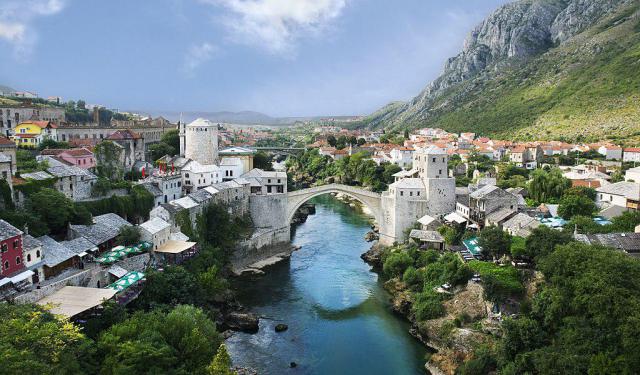
Koski-Mehmed Pasha Mosque, Mostar (must see)
The minaret of the Koski-Mehmed Pasha Mosque is not as high as that of its elder sibling, the Karadjoz-Beg Mosque, also of Mostar. Still, from its position on the banks of the Neretva River, it stands out above all other buildings of Mostar.
Mehmed Koskija, founder of the Koski-Mehmed Pasha Mosque, died in 1611. He was the chronicler of the Grand Vizier of the Ottoman Empire, Mehmed-Pasa Sokolovic. After Mehmed Koskija's death, the mosque was finished in 1619 by his brother, Mahmud, who also added a school. The mosque is a prime example of classical Islamic architecture in Bosnia-Herzegovina.
Designed in the main architecture office of Istanbul, the basic concept of the mosque called for a one-space floor plan with a dome. It resembles the older Karadjoz-Beg Mosque, which probably served as a model. The lower minaret of the Koski-Mehmed mosque lacks stalactite decorations around the balcony of the minaret.
The mosque has a porch with three domes. Inside, the prayer niche and pulpit are exceptionally crafted. The mosque suffered damage in the civil war of 1993. The restoration period lasted from 1996 to 2001. The Koski-Mehmed Pasha Mosque has a collection of rare manuscripts from the Quran, and carpets gifted by the old Austrian monarchy.
Mehmed Koskija, founder of the Koski-Mehmed Pasha Mosque, died in 1611. He was the chronicler of the Grand Vizier of the Ottoman Empire, Mehmed-Pasa Sokolovic. After Mehmed Koskija's death, the mosque was finished in 1619 by his brother, Mahmud, who also added a school. The mosque is a prime example of classical Islamic architecture in Bosnia-Herzegovina.
Designed in the main architecture office of Istanbul, the basic concept of the mosque called for a one-space floor plan with a dome. It resembles the older Karadjoz-Beg Mosque, which probably served as a model. The lower minaret of the Koski-Mehmed mosque lacks stalactite decorations around the balcony of the minaret.
The mosque has a porch with three domes. Inside, the prayer niche and pulpit are exceptionally crafted. The mosque suffered damage in the civil war of 1993. The restoration period lasted from 1996 to 2001. The Koski-Mehmed Pasha Mosque has a collection of rare manuscripts from the Quran, and carpets gifted by the old Austrian monarchy.
Want to visit this sight? Check out these Self-Guided Walking Tours in Mostar. Alternatively, you can download the mobile app "GPSmyCity: Walks in 1K+ Cities" from Apple App Store or Google Play Store. The app turns your mobile device to a personal tour guide and it works offline, so no data plan is needed when traveling abroad.
Koski-Mehmed Pasha Mosque on Map
Sight Name: Koski-Mehmed Pasha Mosque
Sight Location: Mostar, Bosnia-Herzegovina (See walking tours in Mostar)
Sight Type: Religious
Guide(s) Containing This Sight:
Sight Location: Mostar, Bosnia-Herzegovina (See walking tours in Mostar)
Sight Type: Religious
Guide(s) Containing This Sight:
Walking Tours in Mostar, Bosnia-Herzegovina
Create Your Own Walk in Mostar
Creating your own self-guided walk in Mostar is easy and fun. Choose the city attractions that you want to see and a walk route map will be created just for you. You can even set your hotel as the start point of the walk.
Bosnian War Tour
After the fall of Yugoslavia, there followed civil wars of particular savagery. In Bosnia, there were two distinct struggles. The first involved Serbs against Croats and Bosnians. The alliance of Croats and Bosnians proved effective, and the Serbs were repulsed. The Croats were mainly Christian, and the Bosnians were Muslim. There was antipathy between them.
The second part of the war was the... view more
Tour Duration: 1 Hour(s)
Travel Distance: 1.5 Km or 0.9 Miles
The second part of the war was the... view more
Tour Duration: 1 Hour(s)
Travel Distance: 1.5 Km or 0.9 Miles
Mostar Introduction Walking Tour
Settlements by the Neretva River, between Mount Hum and Mount Velez, go back to prehistoric times. Remains of fortified encampments, cemeteries, and Roman foundations have been discovered beneath present-day Mostar. The name Mostar was derived from a document dated 1474. It called the residents "Mostari" which means "bridge-keepers."
Mostar was strategically located between... view more
Tour Duration: 1 Hour(s)
Travel Distance: 1.6 Km or 1 Miles
Mostar was strategically located between... view more
Tour Duration: 1 Hour(s)
Travel Distance: 1.6 Km or 1 Miles


